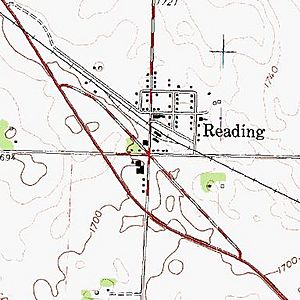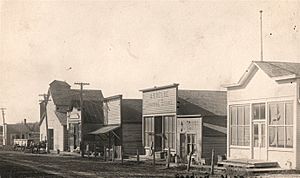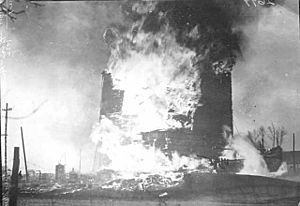Reading, Minnesota facts for kids
Quick facts for kids
Reading
|
|
|---|---|
| Country | United States |
| State | Minnesota |
| County | Nobles |
| Elevation | 1,703 ft (519 m) |
| Time zone | UTC-6 (Central (CST)) |
| • Summer (DST) | UTC-5 (CDT) |
| ZIP code |
56165
|
| Area code(s) | 507 |
| GNIS feature ID | 649856 |
Reading is a small, unincorporated community located in Nobles County, Minnesota, in the United States. An "unincorporated community" means it's a place where people live, but it doesn't have its own local government like a city or town.
Contents
Where is Reading?
Reading is located in the state of Minnesota, in Nobles County. It is about 7.5 miles (12.1 km) northwest of a larger town called Worthington. Some people say Reading is closer to the very center of Nobles County than any other community!
Reading has its own post office, and its ZIP code is 56165.
Roads in Reading
The main roads that help people get to and from Reading include:
 Minnesota State Highway 266: This highway used to connect Reading to other towns. However, in 2003, it was renamed and became Nobles County Road 25.
Minnesota State Highway 266: This highway used to connect Reading to other towns. However, in 2003, it was renamed and became Nobles County Road 25. Nobles County Road 25: This road is important for local travel.
Nobles County Road 25: This road is important for local travel.
The History of Reading
How Reading Began
The story of Reading began in 1876 when a man named H.H. Read claimed much of the land that the community now sits on. He farmed this land for 23 years.
Then, in 1899, the Burlington, Cedar Rapids and Northern Railway decided to build a railroad line through the area. A person named Thomas H. Brown, who worked for the railroad, bought about 27.5 acres of land from H.H. Read. This land was bought to create a new townsite. Brown also bought 20 more acres from George Dayton, a banker and real estate dealer from Worthington. George Dayton later became famous for starting the Dayton's Department Store chain.
In the fall of 1899, the first train arrived in Reading, and A. J. Keller became the first station agent. Early in 1900, two companies, H. H. Douglas and the Rothchild Grain Company, built large buildings called grain elevators in Reading. These were used to store grain from local farms. Other businesses quickly followed, including places to buy coal and lumber, set up by James S Ramage.
By the summer of 1900, when the town was officially mapped out, Reading had grown quite a bit. It had a general store, a hardware store, a blacksmith shop, and a restaurant. A church, the Summit Lake Presbyterian Church, was moved into town from the countryside. A small school house was also moved to Reading so that the children could get an education. The Reading State Bank opened in 1902. In 1905, the Farmer's Mutual Telephone Company was started, connecting Reading with nearby towns like Rushmore, Wilmont, and Fulda.
Later Years in Reading
The Burlington Railroad, which helped start Reading, was later taken over by the Rock Island Railroad. This railroad line operated until the 1970s. In the 1980s, the railroad stopped using the line, and the tracks were removed.
In 1949, Minnesota State Highway 266 was built. This highway connected Worthington, Reading, and Wilmont. The State of Minnesota took care of this highway for 50 years. However, in 2003, the responsibility for maintaining the road was given to Nobles County. Since then, it has been known as Nobles County Road 25.




